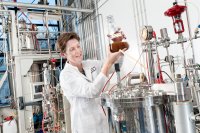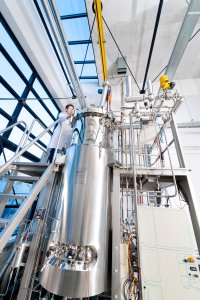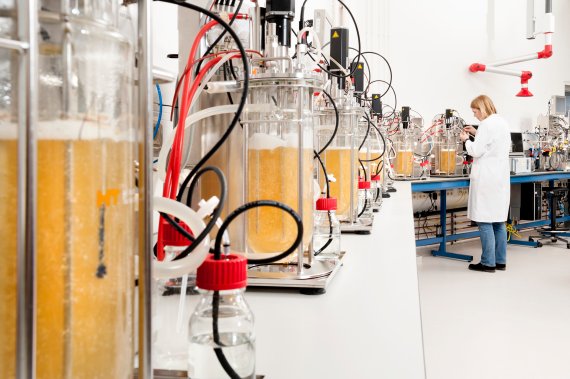text Tessa Louwerens photos Wageningen Food & Biobased Research

Without fermentation, we would not be able to enjoy a piece of cheese or a beer. The microorganisms involved are essentially mini-factories that convert organic compounds into different — tasty or useful — organic substances. That is an interesting subject for scientists too. They want to know how to control the conversion processes to make the mini-factories produce what they want.
‘Awareness has been growing in the past few decades that we can make good use of microorganisms,’ says Eddy Smid from the Laboratory of Food Microbiology. ‘As a result, we no longer just look at the negative effects of microorganisms, such as disease and decay, but we also study the positive aspects such as fermentation.’
Older than the RomansFermentation is the process whereby bacteria, yeast and fungi convert sugars into other substances such as alcohol and acids. It is even older than the Romans: archaeologists think fermented food began to be produced between 10,000 and 15,000 years ago, around the same time as the start of agriculture. There were no fridges, and farmers had to preserve their surplus grain, grape juice and milk somehow. One way of doing so was to use fermentation. Not that they knew about the crucial role played by microorganisms: we only found out about them 150 years ago thanks to Louis Pasteur.
Clean label
Fermentation can be used to manufacture ‘clean label’ products. Consumers increasingly want ‘purely natural’ products without additives and E numbers, so food producers are desperately looking for ‘natural’ ingredients. They are not always readily available, explains Smid, so scientists make them in the lab. ‘Fermentation is a natural method for obtaining the necessary ingredients, such as vitamins, flavourings or preservatives.’
There are lactic acid bacteria, for instance, that make substances that inhibit the growth of other bacteria. They can be used as a natural preservative. ‘If manufacturers just add a substance, they have to report it as an E number,’ explains Smid. But that requirement does not apply if the manufacturer adds a bacterium that produces the same substance. Then the addition can be labelled ‘fermented sugar’, for example. Smid: ‘It’s often exactly the same substances, and they are also available as E numbers. Those E numbers are often made using natural methods as well but consumers don’t trust them.’
Nutritional value
Microorganisms can also increase the nutritional value of food. Manufacturers can use bacteria to add vitamin B12 to vegetable products. This vitamin is normally only found in animal products. ‘Animals themselves can’t make B12,’ explains Smid. ‘Cows obtain it from the bacteria in the rumen and we then get it from meat and milk products. Bacteria can make vitamins. But we only started exploiting this fact about 20 years ago.’
Not only are fermented products nutritious and longer lasting, they also often taste better, says Smid. Sprouts, for example, are fermented to make them sweeter. ‘People often compare the process to rotting but the crucial difference is that when food rots, undesirable microorganisms get the upper hand whereas in fermentation it’s the desirable microorganisms.’
Chemical industry
It is not just food microbiologists who love fermentation; the chemical industry is also interested, says Jeroen Hugenholtz, senior fermentation expert at Wageningen Food & Biobased Research. It is used for producing chemical building blocks for coatings and plastics. They are then made not from petroleum but from renewable materials such as straw, sugar beet leaves or the water used to clean potatoes. In a bioreactor, bacteria from these raw materials can make fatty acids for use in lubricants or surfactants for use in cleaning agents.
Hugenholtz: ‘Fermentation is affordable because we are reusing waste streams. What is more, the process is energy efficient because the microorganisms do their work at low temperatures. This makes it more sustainable and better for the environment, especially if they are using waste streams that aren’t suitable for consumption.’

Biofuel
Another promising application of fermentation is the production of fuel. ‘Aviation companies will have to use at least 20 percent biofuel by 2020, which is why we are looking for sustainable alternatives,’ explains Hugenholtz. ‘We are starting to realize that we will never be able to produce enough biodiesel from rape or other crops.’
It has already been demonstrated in the laboratory that microorganisms can be used to produce aviation fuel from agricultural residues or organic waste. Fermentation of this organic material can produce acetone, isopropanol, butanol and ethanol, compounds that can be turned into hydrocarbons for diesel and aviation fuel in just a few chemical steps. However, the low oil prices are currently an obstacle to the further development, says Hugenholtz. ‘The companies are not yet inclined to make the switch on a large scale, so the ongoing research is dependent on grants.’ That is why coatings and bioplastics are the main industrial applications at present.
Tinder
A mixture of different species of bacteria are normally used rather than just a single bacterium. One bacterium can convert the cellulose in the plant matter into sugars after which another bacterium can ferment them, for instance. ‘These mix cultures ultimately often work better than genetically modified organisms because genetic alterations frequently disappear again after a few generations of bacteria,’ explains Hugenholtz. ‘So you have to keep remaking them.’
Genetically modified organisms are never used in the food industry anyway, says Smid. ‘It is possible and it used to be one of our focus areas, but there’s just too much opposition. We have got all kinds of things available, such as microorganisms that produce additional vitamins or sweeteners with fewer calories. But they are not being used.’
Now scientists are trying to let nature do more of the work, for example by letting bacteria evolve in the lab until they have the desired properties. Or by using mix cultures. Smid: ‘If you bring the critters in contact with one another, that can lead to beautiful new things.’ He calls it Tinder for bacteria. ‘Once we understand this process better, we will be able to make more complex products.’ Hugenholtz confirms this. ‘Interest in fermentation is increasing and there are a lot of opportunities.’
And so we are seeing a new kind of industrial revolution quietly taking place. Not with huge steam engines but with minute creatures that can make all kinds of things.

